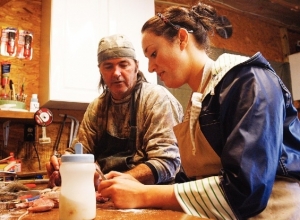Memories stuffed forever
By Laura Collins
Published in News on January 4, 2010 1:46 PM

News-Argus/MITCH LOEBER
Laura Collins gets advice from taxidermist Chuck Gould while she skins a squirrel for mounting.
The Job: Taxidermist
The Company: Mounted Memories
The Location: Mount Olive
I really need to start thinking before I talk.
"Are you squeamish?" asked Chuck Gould, owner of Mounted Memories Taxidermy.
"No, not at all," I quickly answered. But then I got to thinking, I have no idea whether I'm squeamish or not. I've never been around anything particularly gross. I cover my eyes during scary movies, but I don't know if that counts.
So I showed up at Mounted Memories in Mount Olive willing to try anything and wearing my raincoat because Gould said to wear something I don't mind getting blood on.
When I first walked into his shop, I saw a vast collection of mounted animals hanging on the walls and displayed on tables. One was particularly unnerving.
"I think that one is making eye contact with me," I said.
"It's supposed to," was Gould's simple answer.
Once at his working station, Gould laid out two gray squirrels for us to work on. My job was to remove its hide completely. With the squirrel on its back, we used surgical steel blades to cut down the center of its body. From there, we needed to removed the hide from its midsection, working our way up to the head and down to the feet.
"It's just like peeling an orange," Gould said, ruining oranges for me forever.
Well into peeling back the hide, I looked over at the squirrel Gould was working on and noticed something different about his squirrel.
"What's that?" I asked.
"That's just where I stuck my finger through his intestines," he said and continued to work. At that point I looked at Gould's squirrel as little as possible.
About 45 minutes after we started, I finished removing the hide. I felt pretty good about myself until I found out it typically takes Gould about five minutes to do the same thing.
Next we worked on a white-tailed buck, removing his hide from his head. Watching Gould work is like watching an artist. He reminds me of the Bob Ross of taxidermy saying things like, "The animals create themselves. I just help them along a little bit."
The precision and care that he uses are remarkable. It's evident he knows the animals he works on and understands the meaning they have for his customers.
"People like to preserve their trophies. Any deer that's worth it to them to mount, is a memory," he said. "They can tell you where they were, who they were with and the circumstances surrounding it."
Later, we worked on a small mouth bass. I skinned the fish except for the head, then we focused on removing the flesh. Gould told me we were "cheeking" the fish. At the time, I didn't know what cheeking was, and now that I do know, I still wish I didn't.
Basically, the only way to remove the meat from the fish's cheeks is through the eye socket. The suction sound a fish eye makes coming out of the socket, I can still hear when I close my eyes. The only point I admitted defeat was when I needed to hold the fish eye out of the socket with one hand, and cut the cords connecting it to the head with the other. It was the cord cutting that pushed me over the edge.
"Nope. Not going to happen. I can't do it," I said, and stuffed the fish eye back in its socket.
I ended the day working on a female mallard. Since ducks are intricate and you have to be careful not to damage the feathers, I mostly watched Gould work.
"Ducks can be difficult. We're taking something that's dead and making it look like it's flying," he said. "The odds are stacked against you with a duck. Not only was it shot, but a dog went out and got it as well."
It's possible that the average person has no idea how much time, work and precision go into taxidermy. Removing the hide and flesh is only the first of many steps. From there, the hide is washed in skin preparation, treated in a presoak and then washed. Next it is dried with a towel and turned inside out so a dry preserve can be applied to prevent any hair from falling out. Then it is put in a tumbler with sawdust until the hide is completely dry. In the meantime, extensive work is done to the mannequin to get it ready for the hide, including epoxy work. Once dry, the hide is stretched over the mannequin and glued and pinned in place for 10 days while it's in a drying room with a dehumidifier. After 10 days, the pins are taken out, final epoxy work and touch up work around the eyes is completed.
All this for that prized trophy -- but it is much more than just for bragging rights.
Every one of these animals has a story to tell -- as do the men, women and children who decide to preserve them.
It really is about making memories -- and making sure they will last forever.
